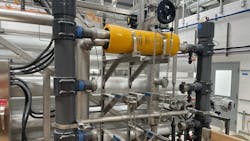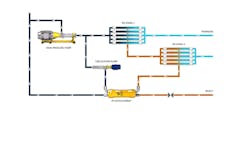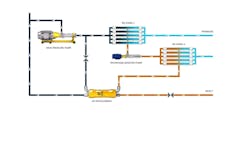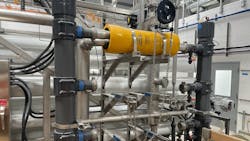Solutions for low-pressure reverse osmosis in municipal water reuse
Current global freshwater withdrawals are approximately 4 trillion cubic meters per year and rising, straining available freshwater resources. It is vital that communities find new and diverse sources for water as demand continues to increase due to population growth and extreme weather brought on by climate change, such as drought.
Municipal facilities are looking for ways to meet water supply and discharge requirements in energy-efficient, cost-effective, and sustainable ways. Low-pressure desalination and water reuse offer viable and effective means to augment water supply, meet water quality requirements, lower costs, satisfy sustainability initiatives, and implement a circular water economy.
Wastewater management systems were traditionally designed to apply the minimum level of treatment necessary to meet environmental discharge requirements, with water supply systems set up separately and often far from wastewater discharge locations. Although the benefits and opportunities for water recycling have been recognized for decades, the perceived risk of poor water quality and the challenge of processing this water efficiently have been both a practical challenge and a public acceptance issue. In addition, the wastewater streams can have highly variable composition, straining the effectiveness of many treatment technologies. Specifically, heavy metals, organics, and other trace contaminants are difficult to treat and present significant health risks if not fully removed from water supplies.
Reverse osmosis offers an effective solution
The advent of membrane treatment methods, particularly reverse osmosis (RO) technology, has made it possible to filter out even the most minute contaminants. As a result, RO is increasingly gaining ground as a potable reuse technology. Potable water requires high purity levels to meet human health and domestic water quality standards. The addition of RO purification to traditional secondary or tertiary municipal wastewater treatment has proven effective over a range of system scales, from small community treatment plants to mega-plants serving cities with a population of millions. However, energy consumption by these systems can be significant, representing both a cost issue and a greenhouse gas source. RO systems can consume significant amounts of energy, and if improperly designed and equipped, they can suffer maintenance issues and downtime. Municipalities need solutions that save energy without compromising reliability.
Energy recovery devices deliver affordability
Many parts of the world lack freshwater resources. The development of seawater RO has allowed populations to grow in arid climates, but this technology was initially limited by its high energy requirements. The PX Pressure Exchanger from Energy Recovery is an option that offers solutions for municipal water reuse technologies with those energy concerns in mind.
The PX is an isobaric energy recovery device (ERD) that captures the otherwise wasted pressure energy of the concentrated reject stream and recycles it within the RO process. With a peak efficiency of 98%, devices cut the energy consumption in a seawater RO system by up to 60%. Today, more than 30,000 devices have been installed worldwide, many operating under harsh conditions and with a design life of 25 years. PX devices enable the production of fresh water from the sea, which is relied upon by millions of people for their businesses, food supplies, and homes.
Municipal, brackish, and industrial water RO systems operate at relatively low pressures of 100 to 400 psi or 7 to 27.5 bar. Building upon the efficiency and performance of the seawater PX, the low-pressure PX (LP PX) can reduce energy consumption in brackish and wastewater RO applications by up to 30%, lowering energy costs and enabling sustainable use of saline water and wastewater resources.
A key characteristic of this technology is its flexibility across a wide flow and pressure range, including the varying feed stream properties and operating regimes of low-pressure RO systems. While pump and turbine efficiencies reduce sharply with flow and pressure changes, these low pressure units are positive-displacement devices, delivering constant high performance. There are no electrical connections or control settings because they automatically adjust to variations in system operating conditions. With only one moving part — a durable ceramic rotor riding on a frictionless hydrodynamic bearing — uptimes of up to 99.8% can be expected, with no scheduled maintenance.
Low pressure for new water treatment projects
When a new RO plant is designed with this technology, the size of the high-pressure pump can be reduced because it only needs to supply part of the flow required by the RO membranes. The rest of the feed is delivered from the devices and is driven by pressure energy recycled from the concentrated reject stream.
This is an effective way to reduce energy consumption, but there are other challenging performance requirements that are unique to low-pressure RO systems. They must maximize water efficiency by extracting as much fresh water from the source stream as possible, minimizing waste, and adapting to changing water conditions, including flow rates, composition and temperature.
Multiple stages are used to maximize concentration in low-pressure RO systems, thereby maximizing freshwater output and minimizing waste reject. Care must be taken to balance flux, which is a measure of the permeate flow across a membrane’s area, throughout a multi-stage RO system so that none of the membranes are over-stressed or under-utilized.
Optimum flux distribution prevents membrane fouling and increases water production. To achieve this, multi-stage low-pressure RO systems are equipped with interstage booster pumps and energy recovery devices. Two process configurations — Balanced and Classic — are shown below.
In the Classic configuration (Figure 1), the low pressure unit is paired with a circulation pump, using pressure from the final reject stream to feed the first stage. Multiple stages operate at higher water recovery rates and produce less waste than single-stage systems. This configuration is ideal for seamless retrofit implementation of energy recovery devices on existing low-pressure RO trains. In particular, this is ideal when operators are looking to increase overall permeate production without having to retrofit the existing high pressure pump.
Regarding the Balanced configuration (Figure 2), the feed pressure to the second RO stage is boosted by an interstage pump. The interstage boost helps to balance the flux rates across all stages by increasing the flux to the second stage and decreasing it in the first stage. Balanced flux rates ensure that both membrane arrays are working equally hard and, therefore, fouling at the same rate. This simplifies the cleaning regimen. The lower pressure RO devices in both the balanced and classic configurations can achieve up to 97% energy recovery efficiency. Energy Recovery provides comprehensive global support to RO plant designers, while delivering high-performance standards, validated with 100% factory testing and guaranteed for each of the low pressure devices.
Low pressure RO for existing water treatment projects
For existing RO systems that seek to expand train capacity, plant operators can implement the technology without changing the high-pressure pump. The devices work in parallel with the existing high-pressure pump, providing additional feed flow and the ability to add more RO membranes.
Adding stages also increases water conversion efficiency and reduces waste reject flow, and both changes increase freshwater production. When it comes to retrofit installations, the implementation timeline can be much shorter compared to new projects.
Low pressure RO in action
Municipal reuse (potable and non-potable) and industrial wastewater treatment are the most common applications of low-pressure RO. The payback period of low-pressure RO systems operating at pressures down to 100 psi (7 bar) can be as low as three years at average power prices. In regions with relatively higher power costs, that timeline can be closer to two years, yielding cost and performance benefits for the life of the plant.
The island of Hawaii was the setting of the first installation of such a device, where the cost of energy is $0.30/kWh. The owner of a brackish well in Kona Village implemented the lower pressure RO units and reduced the operation’s energy cost by $27,000 per train, providing rapid payback.
Another example is Kimley-Horn, the designers of a brackish water reverse osmosis system in Florida, who collaborated with Energy Recovery. The engineering and design team’s goal was to produce 2 million gallons per day (MGD) or 7,600 cubic meters per day (m3/day) of potable water by treating brackish salt water from local wells.
The facility has two RO trains, each producing 1 MGD, designed to expand to produce 2.5 MGD each as demand for water rises. The LP PX technology saved the plant an estimated 1.7 kWh for every 1,000 gallons of permeate, worth approximately $23,360 USD annually.
Well water supplies are expected to increase in salinity, but the plant is ready to adapt to the change with flexible, high-efficiency LP PX technology.
A new era for energy recovery
These low pressure RO devices help industries and municipalities ensure water supply in the face of increasing demand despite the challenges of drought and climate change. The ultimate goal of a circular water economy is achievable by engaging in water reuse with the latest advancements in technology and can also help meet regulations and manage costs.
Taking these and other technologies into account leads to a comprehensive and forward-thinking strategies to improve the environment and the business operation of water reuse systems.
About the Author

Eric Kadaj
Eric Kadaj, Sr. Director of Market and Applications Development, Energy Recovery, Inc.
For more than 20 years, Eric has applied his engineering and technical expertise to drive greater sustainability within the desalination and industrial wastewater space, including process design and implementation, operational strategies, and novel discoveries that minimize environmental impacts.



